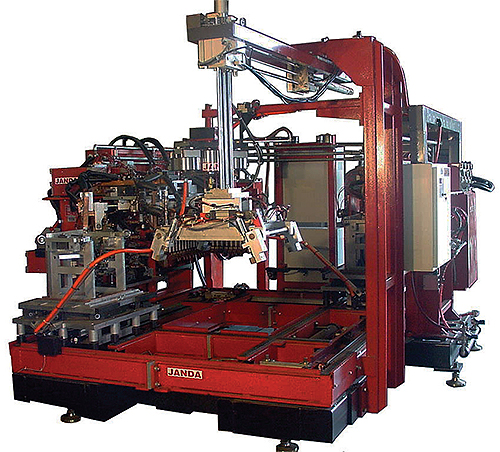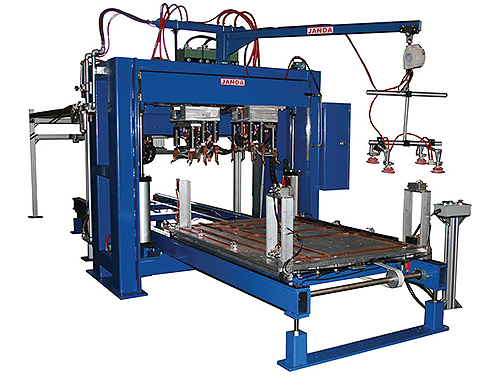Manual welding can be slow, cumbersome, and risky. Typically, welders must precisely position an object on the welding table, lower the cylinders that weld the object together, and move the completed product to the next stage of the manufacturing process. The welded piece is often heavy and the repetitive lifting motions pose many ergonomic and safety risks to employees.

Janda welding machines are fitted with Allen-Bradley MicroLogix or Allen-Bradley SLC 500 controller. For machines needing a small footprint with high performance, an Allen-Bradley CompactLogix PAC is used.
Some manufacturers, however, recognize these negative factors and are migrating to automated welding processes. For example, Janda Company, Inc. recently updated the control system on its resistance welding machinery to help its customers eliminate physical safety issues, produce higher quality parts faster with fewer people, and reduce scrap.
Before the welding automation update, Janda’s machinery was based on relay logic and cam timers. This type of control system was sufficient when customers needed tolerances of one-eighth inch. However, some of Janda’s customers need tolerances as small as one-ten thousandth inch.
Janda ships machines all over the world so it needed a control platform that could be monitored and repaired from anywhere. That’s why the company turned to Rockwell Automation to update their welding machinery and provide global support.
Depending on the size of the welding machine, Janda engineers use an Allen-Bradley MicroLogix or Allen-Bradley SLC 500 controller. For machines needing a small footprint with high performance, an Allen-Bradley CompactLogix programmable automation controller (PAC) is used.
To address customers’ tight tolerance requirements, Janda engineers may use an Allen-Bradley Ultra 3000 servo drive with a SERCOS interface motion module. When paired with Allen-Bradley MP-Series low inertia servo motors, the servo drives are part of the Allen-Bradley Kinetix Integrated Motion portfolio, which features seamless integration between the controller and servo drives.
If a customer needs a tolerance of one-ten thousandth inch, the Ultra3000 drive and MP-Series motor are the only option. The drive controls positioning of the welding table or the weld guns through the Allen-Bradley controller, reducing the scrap that was produced due to inaccurate welds. In addition, Kinetix servo motors use smart motor technology for automatic identification of correct motor-to-drive connectivity, reducing commissioning time for Janda’s engineers.
The engineering team also equips each Janda welding machine with a touch-screen Allen-Bradley PanelView Plus human-machine interface (HMI). From the HMI, Janda engineers can view the machine’s schedule or reset the machine remotely if needed.
According to the company, the benefits of their control platform upgrade have exceeded their expectations by reducing electrical design time by 25% and assembling machines 30% faster. What’s more, switching from a relay to a single controller-based system also reduced the cost of building their machines. Instead of buying 25 to 50 relays/machine, which took up to eight hours to install, Janda purchases a single controller, which takes just 20 minutes to program.

Each newly configured Janda welder sports a touch-screen Allen-Bradley PanelView Plus human-machine interface (HMI). From the HMI, Janda engineers can view the machine’s schedule or reset the machine remotely if needed.
Where the relay logic used to make maintenance and machine upgrades challenging, the use of a controller or a PAC has simplified things. If a part needs replacing or a component needs to be added, it previously required pulling the entire control panel apart. By using one controller instead, adding a timer takes just one minute, and Janda’s customers don’t have to worry about the contacts on their relays wearing out.
Janda is also able to provide customers with a more consistent and robust electrical system that experiences less downtime. By using the servo drives for positioning control, Janda machines now operate faster with much tighter tolerances, which means customers are able to produce higher quality parts more quickly. Because the entire machine is controlled on a single platform, it can be operated by one person. One customer went from producing 30 parts/hr to producing 200 higher-quality parts/hr, with four less people.
Janda Company Inc.
www.jandawelders.com
Rockwell Automation
www.rockwellautomation.com
::Design World::
Filed Under: Factory automation, AUTOMATION, Drives (servo) + amplifiers, MECHANICAL POWER TRANSMISSION, Motion control • motor controls





Tell Us What You Think!